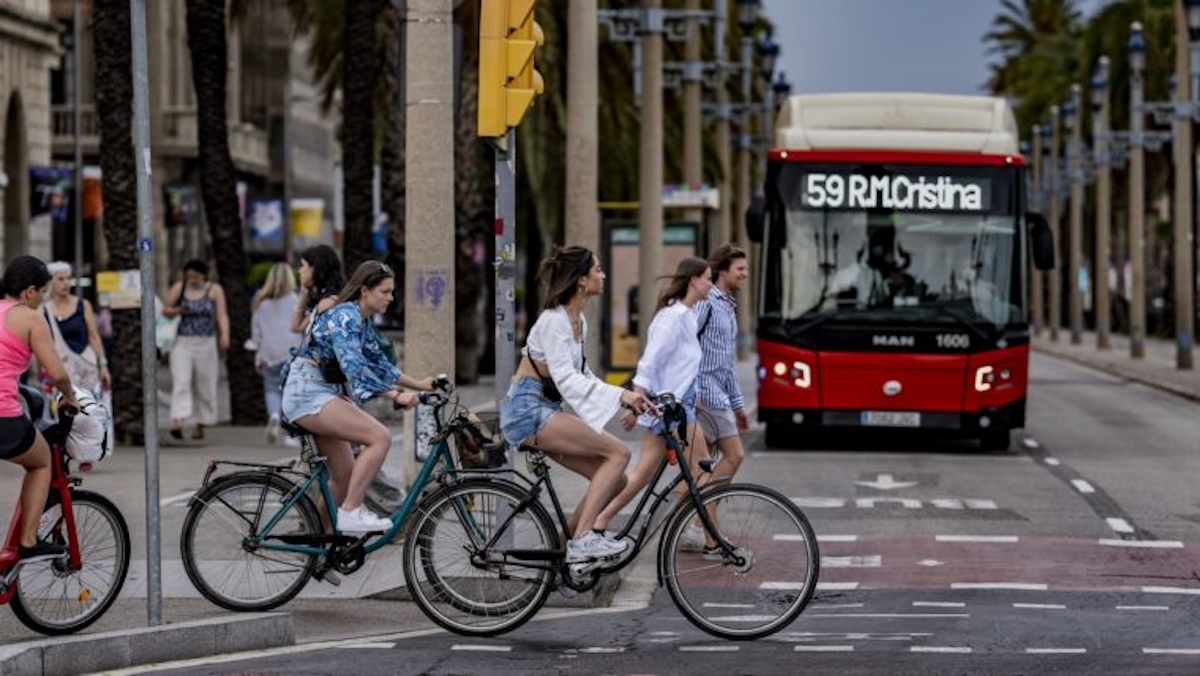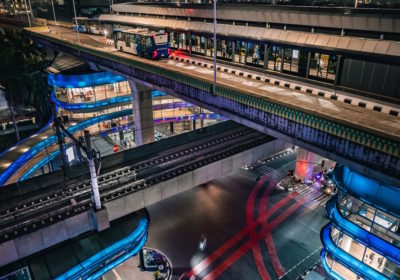Urban mobility is at the heart of the smart city agenda, where data and artificial intelligence (AI) are reshaping how people and goods move through increasingly complex environments. As cities grapple with climate challenges, population growth, and infrastructure strain, AI offers new tools to plan, predict, and optimize transportation systems. We explore how evidence-based strategies and intelligent technologies are driving a transformative shift toward more efficient, inclusive, and sustainable urban mobility across Latin America

The evolution of urban mobility within the framework of smart cities is undergoing a paradigm shift—one that is increasingly driven by data and powered by the exponential capabilities of artificial intelligence (AI). Traditional urban planning models, largely reactive and infrastructure-centric, are being replaced by data-informed, proactive systems capable of not only identifying and interpreting mobility patterns, but also of projecting future demand, optimizing existing infrastructure, and informing inclusive and sustainable public policies. AI emerges not merely as a tool but as a strategic enabler of intelligent mobility ecosystems that can dynamically adapt to urban complexity and social transformation.
The 2025 edition of the Smart City Expo held in Santiago del Estero, Argentina, offered a timely platform for the discussion of how digital innovation, including AI, can be leveraged to improve the quality of life in cities. With over 13,000 attendees, 250 expert speakers, and 150 participating institutions and companies, the event emphasized a holistic approach to digital urban transformation across Latin America. Among the main themes, smart and sustainable mobility stood out as a critical axis, and AI was recurrently framed as a key component for managing the increasing intricacy of urban transportation systems.
In his intervention, Juan Manuel Cavia from Estudio Garibaldi addressed the pressing need to transition from vehicular-centered planning to models that prioritize human mobility and multimodal integration. The proposed framework advocated for the inclusion of sustainable transport solutions—such as electric vehicles, bike-sharing programs, and pedestrian networks—under a unifying design strategy that aligns with urban sensibilities. AI contributes to this shift by enabling the creation of predictive models that consider historical traffic data, real-time movement patterns, and even socio-demographic variables, thus allowing urban planners to simulate different policy scenarios and evaluate their projected outcomes with remarkable precision.
Micromobility solutions, including electric bicycles and scooters, were highlighted by Nelson Negretti, E‑Bikes Specialist at Mirgor, as transformative elements in solving the “last mile” challenge. By incorporating electric bikes into Neuquén’s public bike-sharing system, not only are emissions reduced, but mobility options are democratized, particularly for underserved communities. AI enhances these systems by optimizing fleet distribution through real-time usage data, forecasting demand, and automating maintenance schedules, thereby increasing reliability and operational efficiency.
In the same vein, Santiago Morán, Secretary of Mobility and Citizen Services of Neuquén, stressed the importance of creating an ecosystem in which electric micromobility becomes embedded in the broader urban transportation system. From the development of charging infrastructure to the deployment of apps for citizen engagement, AI plays a critical role in managing the interoperability of diverse transport modes. For example, intelligent routing algorithms can integrate real-time data from buses, bike-sharing systems, and pedestrian traffic to suggest optimal routes to users, reduce congestion, and ensure seamless mobility experiences.
During the panel discussion “Challenges and Innovative Solutions for Mobility,” collaboration emerged as a recurring theme. Jorge Daza, Chile’s Deputy Minister of Transport, alongside Morán and Guillermo Marenco, Secretary of Public Services in San Salvador de Jujuy, highlighted the need for cross-sectoral cooperation to address the challenges posed by AI integration in public infrastructure. While AI presents remarkable potential, it also raises issues around data governance, ethical use, and equitable access to benefits. Nevertheless, when strategically implemented, AI enables adaptive urban governance models capable of responding to evolving urban dynamics with agility and inclusiveness.
One of the most impactful applications of AI in mobility is in the domain of road safety. Intelligent Traffic Management Systems (ITMS) utilize AI to process streams of data from license plate recognition cameras, radar systems, and urban sensors to detect anomalies, identify high-risk zones, and initiate preventive interventions. At Smart City Expo, multiple technologies were showcased that use AI to monitor intersections, detect red-light violations, and analyze accidents in real time. A notable example is the municipality of Florencio Varela, which has integrated AI-based video analytics and command center platforms to detect unsafe behaviors, optimize traffic signal timings, and inform rapid response protocols during emergencies.
Companies like NEC Argentina are advancing this trend with platforms such as CitySensAI, a comprehensive urban intelligence solution that integrates data from IoT devices, surveillance systems, and traffic control infrastructure. According to Mauro Azorín, Key Account Manager for Smart Cities at NEC, CitySensAI leverages machine learning to generate predictive alerts, perform risk assessments, and automate decision-making processes. By harmonizing multiple data streams into a unified interface, AI becomes instrumental not only in analyzing the current state of urban systems but also in forecasting future developments, enabling cities to act before problems escalate.
Equally crucial is the role of data architecture and standardization. María Laura Pagani, Director of the Institute for Transport Studies at the National University of Rosario (UNR), emphasized the significance of integrating georeferenced data and temporal series into urban decision-making. Together with researchers Alejandra Golik and Candela Ciribeni, she demonstrated how crossing official databases with real-time sensor data enables scalable and replicable mobility analyses. AI, particularly when applied to big data, enables the identification of previously undetectable patterns in traffic flow, infrastructure usage, and modal shifts. Such insights can inform decisions regarding public transport frequencies, infrastructure investments, and road network improvements with unparalleled accuracy and responsiveness.
Furthermore, the Rosario Metropolitan Area Logistics and Freight Transport Observatory has employed integrated data systems to map and address bottlenecks in the region’s logistics chain. AI enhances these efforts by enabling dynamic route optimization, real-time congestion alerts, and predictive modeling of cargo flows. As Candela Ciribeni pointed out, installing sensors across public spaces is key for capturing real-time data on speed, density, and conflict points—data that AI systems can analyze continuously to recommend proactive measures.
In discussing methodological rigor, Alejandra Golik highlighted the need for standard protocols in data collection, cleaning, and analysis to ensure statistical validity. AI models are only as robust as the data they are trained on, and ensuring data quality is fundamental for achieving reliable, ethical, and equitable outcomes in AI-powered mobility systems. The researchers from UNR insisted on the need for public agencies to build capacities in data governance and AI literacy to fully harness these transformative technologies.
A compelling example of integrated mobility planning and AI potential is offered by the city of Neuquén, which is rolling out a new electric-assisted bicycle system to complement its existing SiBici shared bike program. The project involves the installation of five strategically located docking stations and a fleet of 100 electric bicycles. According to Noelia Rueda Cáceres, Deputy Secretary for Administrative and Institutional Coordination, these stations are being placed in key urban nodes such as Jaime de Nevares Park, Gustavo Fahler Beach, ETON Bus Terminal, Plaza de las Banderas, and Central Park. Mirgor’s smart e-bike system, equipped with anti-vandalism technology and fully automated locking, charging, and tracking features, showcases the integration of AI at the service of user-friendly and secure mobility experiences.
The Neuquén case exemplifies the potential of AI-informed strategic planning that is grounded in urban analysis, stakeholder engagement, and technological innovation. The project’s development involved not only infrastructure deployment but also the modeling of urban behavior and mobility needs using data analytics, community consultation, and iterative policy design. AI contributed at multiple levels—from determining optimal locations for stations based on usage heatmaps to managing fleet maintenance cycles and monitoring performance indicators over time.
In summary, artificial intelligence is not a mere technological add-on to urban mobility; it represents a fundamental shift in how cities can understand, regulate, and design their transportation ecosystems. When embedded in a robust governance framework, AI has the capacity to make urban mobility systems more adaptive, equitable, sustainable, and resilient. It transforms data into actionable intelligence and opens up new frontiers for proactive, citizen-centered urban planning.



